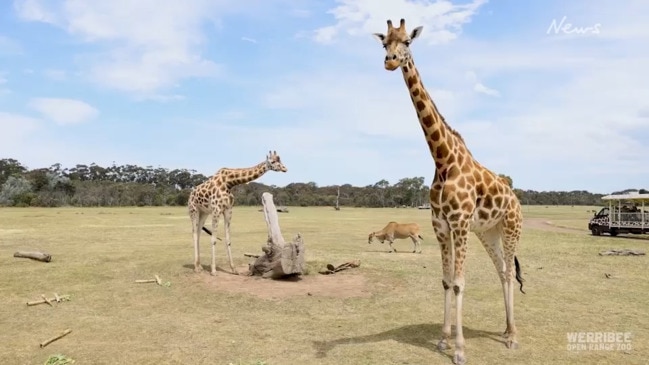Animals get fresh (and funny) with herbs in zoo’s enrichment program
Animals at the Werribee Open Range Zoo have tasted a range of culinary herbs as part of an enrichment program, with hilarious results as camels make it clear they are not fans of pesto

READING LEVEL: GREEN
Ever wondered if camels like pesto? A group of Australian zookeepers may soon find out.
Animals at Victoria’s Werribee Open Range Zoo have been taken on a culinary quest to explore the tastes and smells of a range of different herbs.
Camels, giraffes, servals and wallabies have been given freshly grown herbs as part of an enrichment program that aims to challenge the animals’ senses and understanding of food.
The research shows the importance of trying new foods and how this helps learning.
Zoos Victoria animal behaviour specialist Sue Jaensch said the program was helping to “provide sensory and cognitive challenges for the animals” by giving them the chance to taste something different to what they would normally eat each day.
“This experience is part of one of the many innovative ways that Werribee Open Range Zoo encourages animals to problem-solve and display natural, healthy behaviours,” she said.
The zoo has built a new herb garden that can grow up to 200 types of fragrant plants for the animals to explore.

Ms Jaensch said they had to do some careful research before deciding what to grow for the animals.
“Our veterinary team first makes sure that everything we are planting is safe to provide to each species,” she said. “We also consider and think about the natural history of each species and what similar plants and sensory experiences they might encounter in their natural wild environment to determine what could be interesting to them.”

She said the program has helped zoo staff learn more about what each animal finds tasty “from the tallest giraffe to the smallest reptile.”
It has also given them a good idea of what each animal doesn’t like to eat.
Both the camels and the giraffes at the zoo were given a “herb pesto” or a mix of different herbs to eat.
One of the giraffes spent plenty of time investigating his herbs by walking up to the mix, leaning down and balancing on three legs while extending his tongue to taste.
The giraffe spent a long time chewing and flicking his tongue to explore the tastes and textures of the new food.

When the camels tried the herbs, however, they shook their heads wildly, making their
prehensile, flexible lips fling around.
“Sometimes species respond to herbs by tossing their heads around, which can indicate that they may not like what they’re experiencing,” Ms Jaensch said.
The verdict? It seems camels don’t like pesto after all.
“Sometimes the responses to the herbs are not quite like we expected, but these are really natural for those particular species,” Ms Jaensch said. “We think of some herbs being sweeter or harsher based on our own experiences, but what some people might not know is that birds, for example, love to eat chillies and they don’t seem to be affected by the spiciness.”
A serval seemed to enjoy the catnip it was given, rolling around to cover itself in the mint-like scent.
The wallabies chose to eat the rosemary and mint that was given to them, while one of the rhinos didn’t engage at all with his assortment of fresh herbs.

POLL
GLOSSARY
- culinary: food
- enrichment: making something better
- sensory: relating to the senses: sight, hearing, touch, taste and smell
- cognitive: learning by thinking about things
- innovative: new and groundbreaking
- prehensile: able to grasp things
EXTRA READING
The funniest animal photos from around the world
Tree corridors to save koalas in the wild
Swimming cassowary stuns at beach
QUICK QUIZ
1. Why are zookeepers feeding the animals herbs?
2. How did the camels react after eating their herbs?
3. What did this suggest about whether the camels liked it or not?
4. What spicy fruit do some birds like to eat?
5. What herbs did the wallabies eat?
LISTEN TO THIS STORY
CLASSROOM ACTIVITIES
1. Rewrite the story
Imagine that you are one of the camels in the story. Rewrite the story from your point of view.
Time: allow at least 20 minutes to complete this activity
Curriculum Links: English
2. Extension
Think about a food that you really don’t like at all, the worst! Write a script or create a storyboard. Your purpose is to encourage kids how great and delicious this food is. Include an element that also helps kids to understand why it is important to try new tastes.
Time: allow at least 30 minutes to complete this activity
Curriculum Links: English, Health and Physical Education, Critical and Creative Thinking
VCOP ACTIVITY
Read this!
A headline on an article – or a title on your text – should capture the attention of the audience, telling them to read this now. So choosing the perfect words for a headline or title is very important.
Create three new headlines for the events that took place in this article. Remember, what you write and how you write it will set the pace for the whole text, so make sure it matches.
Read out your headlines to a partner and discuss what the article will be about based on the headline you created. Discuss the tone and mood you set in just your few, short words. Does it do the article justice? Will it capture the audience’s attention the way you hoped? Would you want to read more?
Consider how a headline or title is similar to using short, sharp sentences throughout your text. They can be just as important as complex ones. Go through the last text you wrote and highlight any short, sharp sentences that capture the audience.

